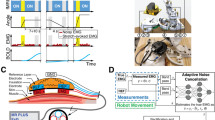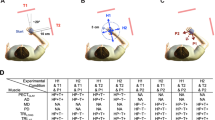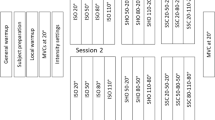Abstract
In man, sudden stretch of an actively contracting muscle evokes a classical monosynaptic spinal reflex followed by an automatic ‘long-latency’ response, both evident as bursts of activity in the electromyogram (EMG)1. This long-latency response, extensively investigated in the human long thumb flexor, but present in many other muscles2, occurs too early to be voluntary and much indirect evidence suggests it represents the operation of a ‘long-loop’, perhaps transcortical, stretch reflex mechanism3,4. Some investigators have found that the long-latency responses may be modified substantially by the subject's intent, possibly by pre-setting of excitability levels within the central nervous system thereby influencing the ‘long-loop’ mechanism5–9. However, others have observed little effect of voluntary set on the automatic long-latency stretch response10,11. It is notable that these studies, which have yielded conflicting results, have involved different muscles in a variety of experimental conditions. In some studies a warning signal preceded muscular stretch, while in others control trials were interspersed with stretches. To resolve the dilemma we have examined the influence of these variables, and found that the automatic long-latency response can be modified most strongly in conditions when the voluntary reaction time is shortest, for example, when the timing of the stimulus can be predicted accurately. We suggest that modification of a long-loop stretch response is not due to some central pre-setting process, but merely represents interaction between a reflex of long latency and a subsequent very rapid voluntary event, occurring early because of predictability of the stimulus.
This is a preview of subscription content, access via your institution
Access options
Subscribe to this journal
Receive 51 print issues and online access
$199.00 per year
only $3.90 per issue
Buy this article
- Purchase on Springer Link
- Instant access to full article PDF
Prices may be subject to local taxes which are calculated during checkout
Similar content being viewed by others
References
Marsden, C. D., Merton, P. A. & Morton, H. B. Nature 238, 140–143 (1972); J. Physiol., Lond. 257, 1–44 (1976).
Marsden, C. D., Merton, P. A. & Morton, H. B. J. Physiol., Lond. 259, 531–560 (1976).
Marsden, C. D., Merton, P. A. & Morton, H. B. Lancet i, 759–761 (1973).
Marsden, C. D., Merton, P. A., Morton, H. B. & Adam, J. Brain 100, 185–200, 503–526 (1977).
Hammond, P. H. J. Physiol., Lond. 132, 17–18P (1956).
Lee, R. G. & Tatton, W. G. Can. J. neurol. Sci. 2, 285–293 (1975).
Evarts, E. V. & Granit, R. Prog. Brain Res. 44, 1–14 (1976).
Iles, J. F. Expl Brain Res. 30, 451–470 (1972).
Colebatch, J. G., Gandevia, S. C., McCloskey, D.I. & Porter, E. K. J. Physiol., Lond. 292, 527–534 (1979).
Marsden, C. D., Merton, P. A., Morton, H. B., Adam, J. & Hallet, M. Prog. clin. Neurophysiol. 4, 167–177 (1978).
Evarts, E. V. & Vaughn, W.J. Prog. clin. Neurophysiol. 4, 178–192 (1978).
Klemmer, E. T. J. exp. Psychol. 51, 179–184 (1956); 54, 195–200 (1957).
Author information
Authors and Affiliations
Rights and permissions
About this article
Cite this article
Rothwell, J., Traub, M. & Marsden, C. Influence of voluntary intent on the human long-latency stretch reflex. Nature 286, 496–498 (1980). https://doi.org/10.1038/286496a0
Received:
Accepted:
Issue Date:
DOI: https://doi.org/10.1038/286496a0
This article is cited by
-
Measurement of stretch-evoked brainstem function using fMRI
Scientific Reports (2021)
-
Participation of ipsilateral cortical descending influences in bimanual wrist movements in humans
Experimental Brain Research (2020)
-
Uncertainty in when a perturbation will arrive influences the preparation and release of triggered responses
Experimental Brain Research (2019)
-
Mechanical perturbations can elicit triggered reactions in the absence of a startle response
Experimental Brain Research (2018)
-
Reflex Circuits and Their Modulation in Motor Control: A Historical Perspective and Current View
Journal of the Indian Institute of Science (2017)
Comments
By submitting a comment you agree to abide by our Terms and Community Guidelines. If you find something abusive or that does not comply with our terms or guidelines please flag it as inappropriate.



